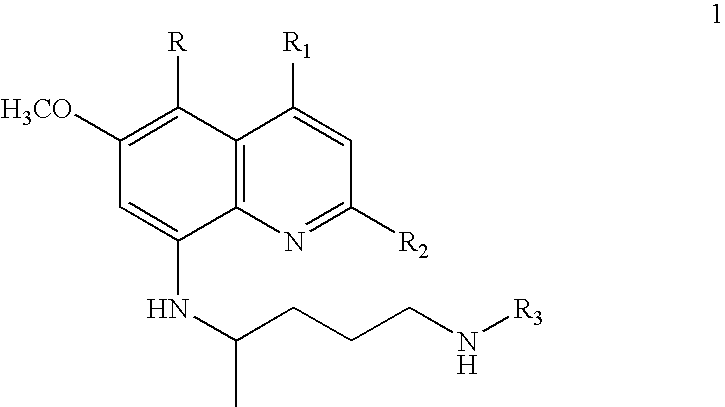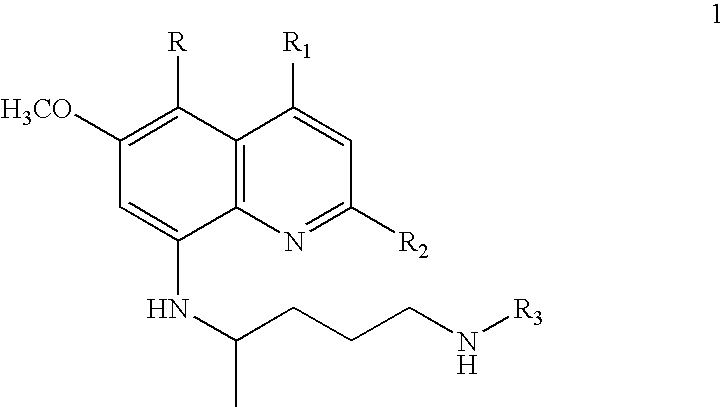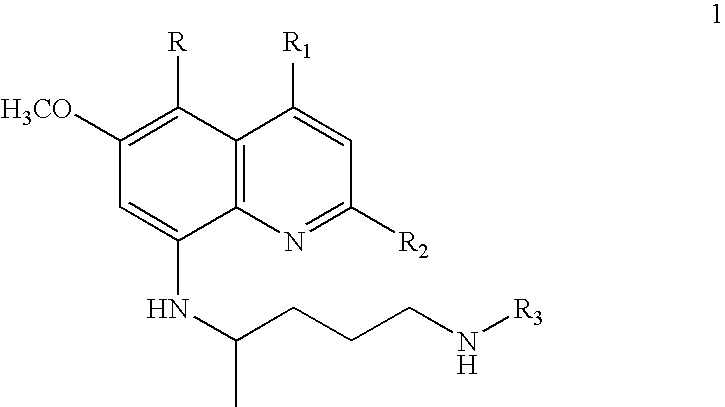Process for preparation of ring-substituted 8-aminoquinoline analogs as antimalarial agents
a technology of 8aminoquinoline and analogs, which is applied in the field of ring-substituted 8aminoquinoline analogs, can solve the problems of malaria remaining a major burden on human health, threatening the health care system of many countries, and especially vulnerable women, so as to reduce the side effects of methemoglobin and reduce the toxicity
- Summary
- Abstract
- Description
- Claims
- Application Information
AI Technical Summary
Benefits of technology
Problems solved by technology
Method used
Image
Examples
example 1
Synthesis of 2-tert-Butyl-6-methoxy-8-nitroquinoline
[0102]6-Methoxy-8-nitroquinoline (1 mmol) (scheme 1) was dissolved in CH3CN (5 mL) while reaction mixture was warmed to 70° C. Silver nitrate (0.6 mmol), trimethylacetic acid (2.5 mmol), and 10% H2SO4 (10 mL) was then added to the reaction mixture. A freshly prepared solution of ammonium persulfate (3 mmol) in water (10 mL) was added drop wise to the pre-heated (70° C.) mixture during 10 minutes. The heating source was then removed and reaction proceeded with evolution of carbon dioxide. After 10 minutes, reaction mixture was poured onto ice, and resulting mixture was made alkaline with addition of 30% NH4OH. Extracted with ethyl acetate (4×50 mL), and combined extracts were washed with NaCl solution (2×10 mL). Dried over Na2SO4 and solvent removed in vacuo to afford oil, which on flash column chromatography over silica gel (230-400 mesh) gave 2-tert-Butyl-6-methoxy-8-nitroquinoline in good yield.
[0103]Yield: 62%; IR (KBr): 1529 an...
example 2
2-tert-Butyl-5,6-dimethoxy-8-nitroquinoline
[0105]Yield: 65%; IR (KBr): 1528 cm−1 and 1349 cm−1 (NO2); 1H NMR (CDCl3): δ 8.05 (d, 1H, 4-Ar—H, J=9 Hz), 7.89 (s, 1H, 7-Ar—H), 7.60 (d, 1H, 3-Ar—H, J=9 Hz), 4.07 (s, 3H, 5-OCH3), 4.02 (s, 3H, 6-OCH3), 1.42 (s, 9H, 3×CH3); HRMS (ESI): 291.2 (M+1).
example 3
2-Cyclohexyl-5,6-dimethoxy-8-nitroquinoline
[0106]Yield: 57%; IR (KBr): 1540 and 1375 cm−1 (NO2); 1H NMR (CDCl3): δ 7.94 (d, 1H, 4-Ar—H, J=9 Hz), 7.75 (s, 1H, 7-Ar—H), 6.93 (d, 1H, 3-Ar—H, J=9 Hz), 3.98 (s, 3H, 5-OCH3), 3.97 (s, 3H, 6-OCH3), 2.92 (m, 1H, CH), 1.25 (s, 10H, 5×CH2); MS (EI): m / z 316 (M+).
PUM
| Property | Measurement | Unit |
|---|---|---|
| Temperature | aaaaa | aaaaa |
| Temperature | aaaaa | aaaaa |
| Time | aaaaa | aaaaa |
Abstract
Description
Claims
Application Information
 Login to View More
Login to View More - R&D
- Intellectual Property
- Life Sciences
- Materials
- Tech Scout
- Unparalleled Data Quality
- Higher Quality Content
- 60% Fewer Hallucinations
Browse by: Latest US Patents, China's latest patents, Technical Efficacy Thesaurus, Application Domain, Technology Topic, Popular Technical Reports.
© 2025 PatSnap. All rights reserved.Legal|Privacy policy|Modern Slavery Act Transparency Statement|Sitemap|About US| Contact US: help@patsnap.com



